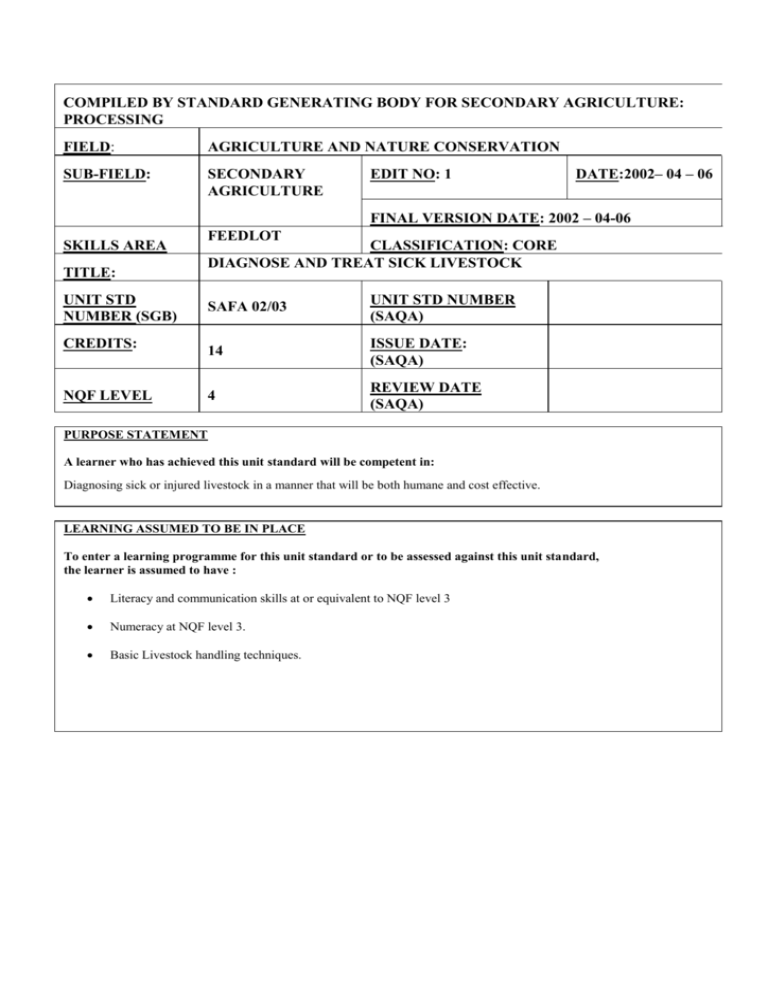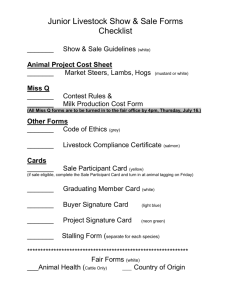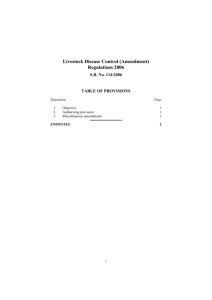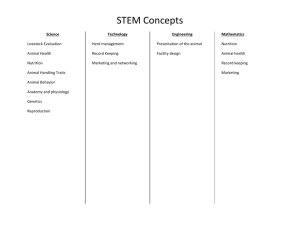SAFA 02/03 - Diagnose and Treat Sick Feedlot Livestock
advertisement

COMPILED BY STANDARD GENERATING BODY FOR SECONDARY AGRICULTURE: PROCESSING FIELD: AGRICULTURE AND NATURE CONSERVATION SUB-FIELD: SECONDARY AGRICULTURE EDIT NO: 1 DATE:2002– 04 – 06 FINAL VERSION DATE: 2002 – 04-06 SKILLS AREA TITLE: FEEDLOT CLASSIFICATION: CORE DIAGNOSE AND TREAT SICK LIVESTOCK UNIT STD NUMBER (SGB) SAFA 02/03 UNIT STD NUMBER (SAQA) CREDITS: 14 ISSUE DATE: (SAQA) NQF LEVEL 4 REVIEW DATE (SAQA) PURPOSE STATEMENT A learner who has achieved this unit standard will be competent in: Diagnosing sick or injured livestock in a manner that will be both humane and cost effective. LEARNING ASSUMED TO BE IN PLACE To enter a learning programme for this unit standard or to be assessed against this unit standard, the learner is assumed to have : Literacy and communication skills at or equivalent to NQF level 3 Numeracy at NQF level 3. Basic Livestock handling techniques. SPECIFIC OUTCOMES A learner assessed as competent against this standard will be able to: Placing the livestock humanely in the handling facility. OUTCOME A: DIAGNOSE SICK AND INJURED LIVESTOCK BY: Assessing illness from symptoms according to diagnoses procedures. Determining level of seriousness of illness or injury. OUTCOME B: DETERMINE RELEVANT MEDICATION ACCORDING TO PRESCRIPTION BY: Applying ability to follow written prescriptions. Applying knowledge to use the correct type of drugs according to prescription. Selecting the relevant medication as per procedure. Assessing the correct volume to be applied per Kg mass according to prescription. Verifying expiry date of medication. OUTCOME C: APPLY THE RELEVANT APPLICATOR AT SITE OF APPLICATION BY: Assuring all applicators are hygienic. Determining the correct applicator according to procedure. Applying treatment at correct site of application according to procedure. OUTCOME D: RECORD DIAGNOSES AND TREATMENT BY: Recording diagnoses and treatment as per procedure. Marking the livestock according to procedure. Placing the treated livestock in the relevant facility according to procedure. ASSESSMENT CRITERIA Assessors will observe, confirm and evaluate evidence that will indicate that learners have demonstrated competence in each of the specific outcomes. In this unit standard the following specific criteria should be used: Explaining the reasons for: Placing the livestock humanely in the handling facility. Assessing the illness from symptoms according to prescriptions Determining the level of seriousness of sickness or injury. Marking livestock according to diagnoses. Explaining the purpose of: Verifying the expiry date of medication. Following the correct prescription. Applying knowledge of using the correct treatment. Recording diagnosis and treatments. Explaining the consequences of not: Ensuring that all applicators are hygenic. Using the correct applicator. Applying treatment to the correct site. ACCREDITATION AND MODERATION PROCESS AND CRITERIA: (Mechanisms and bodies for external moderation of learner achievements) An individual wishing to be assessed against this unit standard may apply to an assessor accredited by SETASA. Any training provider offering learning that will enable achievement of this unit standard must be registered and accredited by SETASA. Moderation of assessment will be done by SETASA in its ETQA capacity or at its discretion. RANGE STATEMENT (General guide for scope, context and level) The scope of this unit standard deals with the diagnosis, drug selection and treatment of feedlot illnesses and injuries. Sickness include but are not limited to respiratory, tick borne, metabolis, nutritional to lung. Injuries includes but not limited to lameness, cuts, abrasions, breaks, abscesses to disorientation. The specific outcomes reflected in this unit standard should be performed without direct supervision but with access to treatment schedules. NOTES (1) CRITICAL CROSS FIELD OUTCOMES: (What abilities must I use) Work effectively with others on a team when treating sick or injured Communicate effectively with others during the process of giving and receiving instruction. Identify and solve problems which may occur when treating sick or injured livestock. Use science and technology when using applicators. Understand the world as a set off related systems by understanding the consequences of incorrect diagnosing or treating of livestock. NOTES (2) ESSENTIAL EMBEDDED KNOWLEDGE (Knowledge that will help me understand and that I will be able to explain) Basic knowledge of various illness conditions in a feedlot. Basic knowledge of relevant treatment for illness conditions. Basic knowledge of site of applications. Basic knowledge of various applicators. Basic knowledge of main medications. NOTES (3) VALUES All learners should demonstrate: An application of company ethics, values as well as general safety principles. An awareness of expectations and obligations of basic worker / management relationships.







